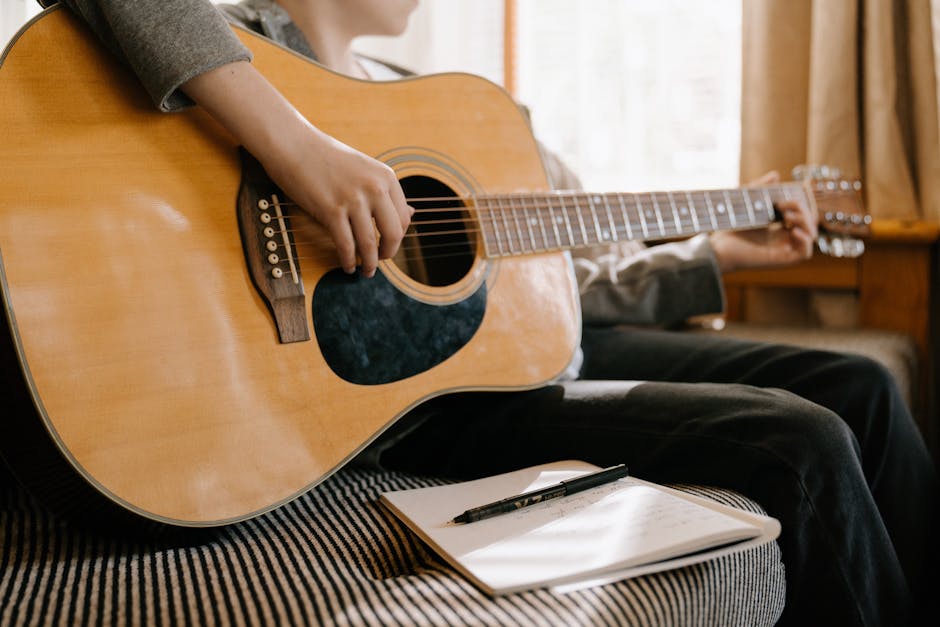Are you tired of strumming the same old chords on your guitar and feeling like a musical novice? Well, fear not, my friend, for I am here to help you elevate your six-string game to the next level! In this article, we will delve into the world of foundational guitar chords that every beginner musician should master. So grab your guitar, tune up those strings, and get ready to rock and roll (or folk and strum, if that’s more your style)! Major Chords: Your First Step in Guitar Mastery“>
Major Chords: Your First Step in Guitar Mastery“>
Contents
- 1 Exploring Major Chords: Your First Step in Guitar Mastery
- 2 Understanding Minor Chords: Adding Emotion to Your Play
- 3 The Versatility of Seventh Chords in Music
- 4 Transitioning Between Chords: Tips for Smooth Play
- 5 Capo Usage: Expanding Your Chord Vocabulary
- 6 Incorporating Strumming Patterns with Chords for Musical Texture
- 7 Barre Chords: Unlocking New Sounds on the Fretboard
- 8 FAQs
- 9 Rock On!
Exploring Major Chords: Your First Step in Guitar Mastery
So, you’ve decided to take on the challenge of mastering the guitar. Congratulations! This journey is going to be full of ups and downs, but trust me, it will all be worth it in the end.
Today, we’re going to dive headfirst into the world of major chords. These are the building blocks of countless songs and will serve as the foundation of your guitar playing skills. It’s like learning your ABCs before you can read a book – essential!
First things first, let’s break down what a major chord actually is. In simple terms, it’s a chord that is made up of three notes – the root, the third, and the fifth. When played together, these notes create a harmonious sound that is sure to make your ears sing.
Now, grab your guitar and let’s get started. Here are a few major chords to kick things off:
- G major
- C major
- D major
Practice strumming these chords until your fingers ache and your strings beg for mercy. Remember, Rome wasn’t built in a day – and neither was Jimi Hendrix’s legendary guitar skills. Keep at it, and before you know it, you’ll be on your way to guitar mastery!
Understanding Minor Chords: Adding Emotion to Your Play
So you’ve mastered those major chords and can strum away with the best of them. But what about those minor chords? They may be small, but boy do they pack a punch when it comes to adding emotion to your playing.
Picture this: you’re strumming along on your guitar, breezing through a few major chords, when suddenly you hit that minor chord and BAM! It’s like a punch to the gut. That’s the power of the minor chord, my friends.
Think of minor chords as the little black dress of the music world – they’re simple, they’re versatile, and they never go out of style. Whether you’re feeling sad, nostalgic, or just in need of a little drama, a well-placed minor chord can convey all that and more.
So next time you’re jamming out, don’t forget to sprinkle in a few minor chords for that extra dose of emotion. Your audience will thank you for it, even if they’re wiping away a tear or two.

The Versatility of Seventh Chords in Music
Seventh chords – they’re like the spice rack of music. Just when you think you’ve heard every flavor, along comes a seventh chord to add a little extra kick to your harmony. These bad boys are so versatile, they can show up in virtually any genre of music and make themselves right at home.
Need to add some tension and suspense to your ballad? Throw in a dominant seventh chord to keep your listeners on the edge of their seats. Looking to inject a little jazzy flair into your tune? A major seventh chord is just what the doctor ordered. And let’s not forget about the sultry sophistication of a minor seventh chord – perfect for setting the mood in a romantic ballad.
But wait, there’s more! Seventh chords aren’t just reserved for slow jams and jazz standards. They can also be found in pop, rock, and even electronic music. Whether you’re jamming out to a funky groove or getting down to a smooth R&B track, chances are you’ll encounter a seventh chord somewhere along the way. It’s like a musical Easter egg hunt!
So next time you’re writing a song or analyzing a piece of music, don’t be afraid to experiment with seventh chords. With their ability to add depth, emotion, and flavor to any musical composition, they’re truly the unsung heroes of the harmonic world. Embrace the versatility of seventh chords and watch your music reach new heights!

Transitioning Between Chords: Tips for Smooth Play
So you’ve mastered playing individual chords on your guitar or piano, but now comes the challenging part – transitioning between chords smoothly. Don’t worry, we’ve got some tips to help you become a chord-changing ninja in no time!
First off, make sure your fingers are properly positioned on each chord before attempting to switch. It’s like trying to put on a tight pair of skinny jeans – if you don’t wriggle in just right, you’ll end up doing the awkward hop dance. Take your time to ensure each finger is in the right place before moving on to the next chord.
Another tip is to practice transitioning between pairs of chords that commonly appear together in songs. For example, **C** to **G** or **D** to **A**. By focusing on these common transitions, you’ll start to develop muscle memory and be able to switch between chords more effortlessly.
Lastly, don’t forget to use a metronome when practicing your chord changes. It may feel like you’re being bossed around by a robot, but keeping a steady beat will help train your brain and fingers to switch chords at the right time. Plus, who doesn’t love pretending they’re in a rock band with their own personal timekeeper?

Capo Usage: Expanding Your Chord Vocabulary
So, you’ve mastered all the basic chords on your guitar but you’re itching to spice things up a bit. Enter the capo – that tiny accessory that has the power to multiply your chord possibilities tenfold!
Instead of sticking to the same old chords, why not experiment with different capo positions? By placing the capo on different frets, you can easily play in different keys without having to learn new chord shapes. It’s like magic, but without the need for a top hat and wand!
With the help of a capo, you can impress your friends with a whole new set of chord progressions that will make them wonder if you’ve been secretly taking guitar lessons from a musical wizard. And the best part? You’ll be expanding your chord vocabulary without breaking a sweat!
So, next time you’re feeling stuck in a musical rut, grab your trusty capo and let your fingers wander to new and exciting chord territories. Who knows, you might just stumble upon the next chart-topping hit!
Incorporating Strumming Patterns with Chords for Musical Texture
So you’ve mastered your basic guitar chords and you’re ready to take your playing to the next level by incorporating strumming patterns for some added flair. Well hold on to your hats, because we’re about to dive into the wild world of strumming patterns and chords!
First things first, make sure your guitar is tuned up and ready to go. No one wants to hear those off-key chords strummed with gusto! Once you’re in tune, grab your guitar and let’s get started.
Now, let’s talk about strumming patterns. These rhythmic patterns can really spice up your playing and give your music that extra oomph. Try out different patterns like the basic down-up strum, the classic folk strum, or the intricate fingerstyle patterns to really wow your audience.
- Experiment with different strumming speeds and dynamics to create different musical textures
- Don’t be afraid to mix up different strumming patterns within one song for added interest
- Remember to practice, practice, practice – strumming patterns can take time to master but the results are oh-so-satisfying!
Barre Chords: Unlocking New Sounds on the Fretboard
Are you ready to take your guitar playing to the next level? Say goodbye to open chords and hello to the wonderful world of barre chords! These versatile finger positions allow you to play all sorts of new sounds on the fretboard that you never thought possible.
Feeling a little intimidated? Don’t worry, we’ve all been there. Barre chords can be a bit tricky to master at first, but with a little practice and determination, you’ll be rocking out in no time. Just remember to keep those fingers nice and strong – it’s like a workout for your hands!
One of the best things about barre chords is that they allow you to play the same chords in different positions on the neck, giving your music a whole new dimension. And the best part? You can impress your friends and family with your new skills at the next jam session!
So grab your guitar, dust off those fingertips, and get ready to unlock a whole new world of sounds. With barre chords in your arsenal, the possibilities are endless. Get ready to blow people’s minds with your newfound guitar prowess – you’ll be the talk of the town in no time!
FAQs
What are the most important foundational guitar chords for novice musicians?
Well, dear novice musician, let me introduce you to the holy trinity of guitar chords: G, C, and D. Master these and you’ll be well on your way to serenading the masses.
Why are these chords considered foundational?
These chords are like the building blocks of all music. Almost every song you’ll ever want to play will include these bad boys in some shape or form. You can think of them as the bread and butter of the guitar world.
How can I practice and master these chords?
Ah, practice makes perfect, my friend. Spend some quality time with your guitar every day, strumming and switching between these chords until your fingers protest and beg for mercy. Trust me, it’ll pay off.
Are there any tips for making chord transitions smoother?
Don’t be afraid to experiment with different finger placements and techniques. And always remember to keep your fingers close to the fretboard for optimal efficiency. It’s all about finding what works best for you, so don’t be shy to mix things up!
What other essential chords should I learn after mastering the foundational ones?
Once you’ve nailed G, C, and D, the world is your oyster, my musical friend. Branch out to E, A, and even throw in some fancy minors and sevenths for good measure. The more chords you know, the more songs you can play!
Rock On!
Congratulations on mastering these foundational guitar chords! Remember, practice makes perfect, so keep strumming those strings and soon you’ll be rocking out like a pro. And who knows, maybe one day you’ll be headlining at Madison Square Garden. But for now, keep on jamming and having fun with your newfound musical skills. Keep on strumming, novice rockstar!



